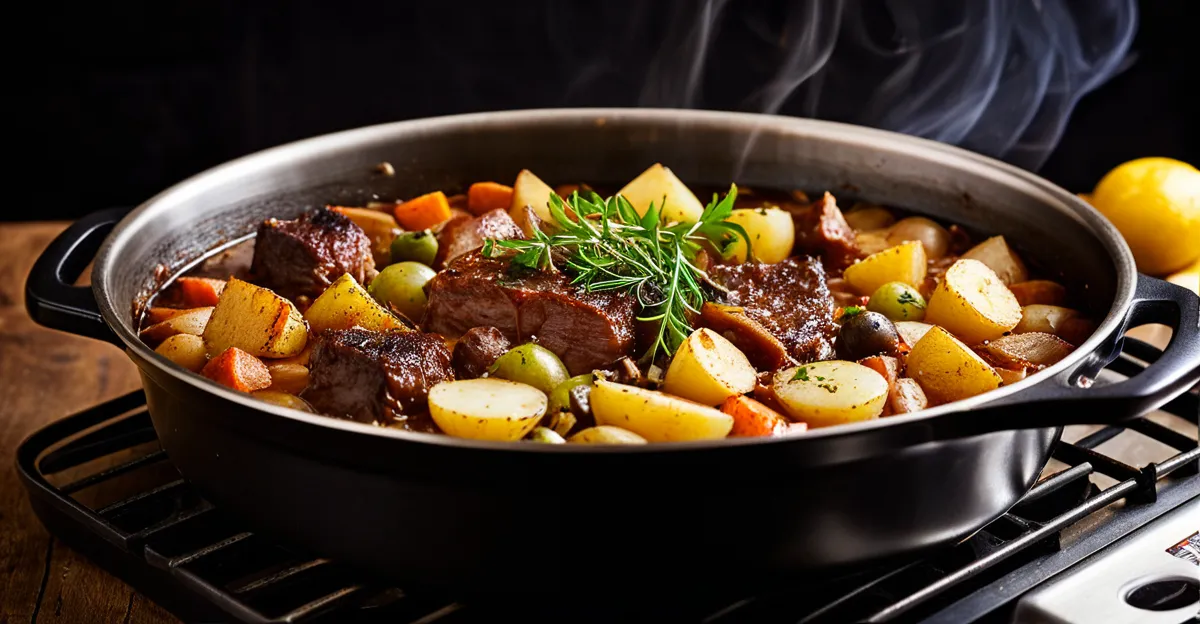Essential Ingredients and Tools for a Hearty Lancashire Hotpot
To create an authentic Lancashire hotpot, focusing on quality ingredients and proper tools is crucial. The core Lancashire hotpot ingredients include rich lamb cuts—usually neck or shoulder—simmered slowly to tender perfection. Root vegetables such as onions, carrots, and parsnips complement the meat while adding natural sweetness and bulk. Potatoes, sliced thinly, form the characteristic crust on top, sealing in the flavors. A well-made stock, often from the lamb itself, is essential to develop the stew’s depth and heartiness.
When considering traditional hotpot cookware, a sturdy, ovenproof casserole dish is recommended, ideally one with a tight-fitting lid to maintain moisture throughout the long cooking time. Cast iron or heavy ceramic pots work best as they distribute heat evenly, preventing hotspots that could dry out ingredients. Additionally, using a sharp knife for prepping vegetables and a ladle for serving helps maintain the structured layering key to this dish.
Topic to read : Discover the Secret Ingredients in Traditional British Meals
There’s room for variation—some cooks enhance the dish by adding herbs like thyme or bay leaves, while others incorporate alternative root vegetables to enrich flavor and texture. Choosing the right ingredients paired with suitable cookware underpins the signature taste and satisfying texture of the classic Lancashire hotpot.
Step-by-Step Method for Maximising Heartiness and Flavour
Mastering the Lancashire hotpot recipe begins with precise cooking steps that enhance flavour and texture. Start by browning the lamb cuts thoroughly; this develops rich, caramelised notes essential to heartiness. Once browned, layer the root vegetables—onions, carrots, and parsnips—carefully atop the meat. This layering seals in juices and allows flavours to meld during cooking.
Topic to read : What are the key spices in a traditional UK curry recipe?
Seasoning is key. Use salt, pepper, and herbs like thyme or bay leaves to deepen the stew’s complexity. For maximum flavour, pour a well-made stock over the layers but avoid submerging everything; the hotpot relies on slow evaporation to concentrate taste.
Assemble in your trusted traditional hotpot cookware, such as a heavy cast iron casserole. This ensures even heat distribution, preventing burning while maintaining moisture. Cover with lid to trap steam. Cook slowly at a low oven temperature, around 150–160°C (300–320°F), for 2.5 to 3 hours. This slow-cooking stage tenderises the meat and softens the vegetables to perfect succulence.
By abiding by these steps, the Lancashire hotpot achieves a robust, hearty flavour and a tender, comforting texture, making it a true classic on any plate.
Choosing the Best Meat and Vegetables
Selecting the best meat for Lancashire hotpot centers on cuts like lamb neck or shoulder. These cuts contain ample connective tissue and marbling, which break down during slow cooking, resulting in tender, flavoursome meat. Using leaner cuts risks dryness, as slow-cooking relies on the fat and collagen melting into the stew.
Vegetable choices significantly influence the stew’s texture and flavour. Classic vegetables include onions and carrots; their sweetness complements the robust lamb. Parsnips add earthiness, and some cooks introduce alternatives such as swede or turnips to enrich the flavour profile. Thinly sliced potatoes on top not only seal in juices but also contribute to the crispy crust crucial for texture contrast.
Sourcing quality, preferably local, produce guarantees freshness and enhances natural sweetness in root vegetables. Fresher vegetables retain their structure better during slow cooking, preventing mushiness. Choosing organic or seasonal ingredients can elevate the dish’s overall taste.
In summary, the best meat for Lancashire hotpot is a fattier, slow-cooking lamb cut, while vegetable choices emphasize a balance between sweetness and earthiness, supporting the stew’s hearty character. This thoughtful ingredient selection ensures a satisfying and authentic hotpot experience.
Techniques and Tips from Experts
When seeking chef tips for Lancashire hotpot, experts emphasize precise layering and heat control. To achieve crispy layered potatoes—a hallmark texture—slice them thinly and arrange overlapping slices evenly atop the hotpot. Lightly dotting the surface with butter or a sprinkle of salt before baking enhances browning. Covering the dish initially retains moisture, but uncovering for the last 20 minutes encourages a golden crust.
Experienced cooks advise careful seasoning at each stage; under-seasoning early leads to blandness, while over-seasoning risks overpowering delicate root vegetables. Layering ingredients thoughtfully, with meat first then vegetables, allows juices to meld naturally, creating depth. Resting the hotpot briefly after cooking helps flavours settle and ease serving.
Common pitfalls include overly high oven temperatures, which toughen meat, and excessive liquid, which dilutes flavour and prevents potato crisping. Utilizing traditional hotpot cookware, like a heavy cast iron casserole, ensures steady heat distribution critical for even cooking.
Incorporating these expert cooking advice points guarantees that your Lancashire hotpot combines tender lamb, infused vegetables, and that signature crispy topping for the perfect hearty meal every time.
Variations and Modern Twists on the Classic Recipe
Lancashire hotpot variations allow flexibility while honouring the dish’s hearty essence. Traditional hotpot recipes often stick to lamb cuts with root vegetables, but regional adaptations introduce elements like kidney for a richer taste or experiment with different herbs such as rosemary or sage to deepen the aroma. These changes retain the characteristic robustness while offering unique flavour profiles.
Modern recipes, including vegetarian hotpot versions, replace lamb with plant-based proteins like mushrooms, lentils, or seitan. These alternatives absorb seasoning and stock well, providing satisfying textures without compromising the dish’s soul. Incorporating seasonal vegetables like squash or celeriac further personalizes the hotpot and aligns it with contemporary eating trends.
Leftover meats, such as roast lamb or beef, can be cleverly used in variations, reducing waste and enriching flavours with minimal extra effort. When adapting, adjusting the layering and cooking time ensures the hotpot remains tender and balanced.
Experimenting with Lancashire hotpot variations embraces creativity while respecting its traditional roots. Whether incorporating new ingredients or trying plant-based recipes, these twists maintain the heartiness and comfort that define the classic hotpot experience.
Addressing Common Questions and Troubleshooting
Many wonder how to achieve the perfect Lancashire hotpot consistency without the stew becoming too dry or watery. The key lies in careful control of liquid and cooking time. Adding just enough stock to create a moist environment, without fully submerging the ingredients, allows slow evaporation to thicken the sauce naturally. Overly wet hotpots can lack depth, while too little liquid risks drying the meat and vegetables.
Adjusting seasoning during cooking is essential. It is best to season in stages—salt and pepper early to build base flavor, then adjust near the end to avoid overpowering delicate root vegetables. If the stew tastes flat or too mild, adding a splash of vinegar or Worcestershire sauce can brighten the flavors.
When reheating leftovers, use a gentle heat setting and cover the dish to prevent drying out. Adding a small amount of stock or water during reheating helps maintain moisture. For freezing, cool the hotpot fully before storage, then reheat slowly from frozen to preserve texture and flavor.
By following these troubleshooting tips and consulting Lancashire hotpot FAQ, both novices and seasoned cooks can enjoy a consistently hearty and comforting dish every time.

